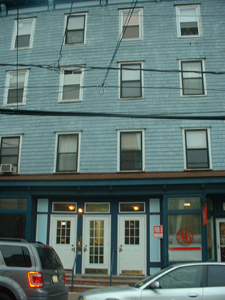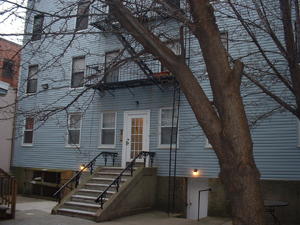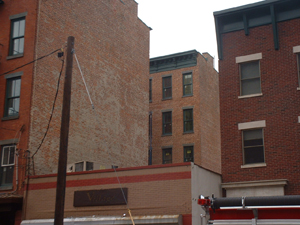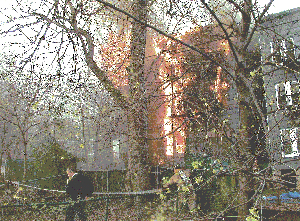“Check the Rear”
You don’t have to be a firefighter in a congested urban city to be mindful of fire conditions in the rear of the building. Buildings of any significant square footage, buildings that are attached in a row, or buildings that extend back from the street for any appreciable distance will require you to take a look at “what is going on in the rear”. In many of what is referred to as your “downtown areas”, firefighters will finds building attached together making up the business district in their town. This may be nothing more than a few commercial buildings attached or placed together, to dozens or more consuming an entire city block. In a more common setting in our nations cities, firefighters will not only find a number of buildings attached together, they will often encounter structures that will vary in height, square footage and layout. Additionally, some may have garages and driveways accessible from a rear alley. Others may have small yards that back up to buildings of similar type and design on a parallel street. While a few might present a unique setting where firefighters may find structures actually erected behind structures on the same parcel of land.
Rookeries:
In the later, we refer to these structures in Jersey City as “rookeries”. A rookery identifies a building that is built totally in the rear, or behind another building in what some would have assumed to be a rear yard. The term “rookery” comes from the definition of “grouping or rambling of buildings in a congested setting” or in this case, within a plot of land. This was a concept intended to maximize the rental income from a parcel of land that was deeper than it was wider. This concept should sound familiar. This was the same practice accomplished with plots of land that were wider than they were deeper. Landowners would erect a row of stores to offset their property taxes in what we still term today as “taxpayers”. Obviously the thought of building structures behind structures gave no regard to the fire service’s need to access the building for fire suppression. Access to a rookery is often limited through a small alleyway along side the building in front of it, or actually through a doorway and hallway in the building in front of it. Their view is often totally consumed by other buildings built around it. Rookery structures can be a framed private dwelling to multi-floored apartment buildings.
 middle door leads to hallway/rear yard to a Rookery
middle door leads to hallway/rear yard to a Rookery view at end of the hallway
view at end of the hallway Class 3 Multiple Dwelling Rookery
Class 3 Multiple Dwelling Rookery
Many firefighters who have these structures don’t even know that they exist. Barring pre-incident information, in Jersey City we often seek them out from alarm information that indicates a “1/2” or an “A” address. For example 110-A or 110-1/2 Main Street in a congested city block points us toward a shared building lot and the probability of a “rookery”. But, we have also found them sharing the same address as the structure in front of them. We always take extra time to take a look.
Ir-Regular Shapes or Add-ons:
Another concern when standing in front of a row of attached buildings is the layout and square footage of the actual fire building. Not all structures we respond and operate at reflect predictable layouts and square footages. Standing in front of a uniformed row of building fronts that we assume all to measure 20 feet wide by 40 feet deep could very well contain a mixed grouping of structures of varying heights, buildings that extend deeper than their neighbors, as well as structures which may wrap-around another. Unless you and your members frequent those buildings or have pre-plan information that highlights the concerns, firefighters may be caught off guard when fire begins or extends to the rear of these type structures.
The obvious concern that must come from the above is the need to conduct reconnaissance of the area. This is more difficult than it sounds. It is without doubt that we should attempt to conduct a multi-sided, preferably 360-degree view of the fire building upon our arrival. But in many situations, this is not possible. The most obvious is when you’re confronted with a significant number of attached buildings making it literally impossible to actually view the rear of these buildings. In situations as described, the quickest way to get a look at the rear is from above.
Walking the Rim:
Ladder Company members assigned to the roof have a clear and early advantage to recon the rear of the building. Members assigned to this position can identify a much different picture than what is viewed and assumed from the Command Post side. Simply, “if it looks bad in the front, it could be much worse in the rear”.

fire conditions in the rear
As members go to work on the roof performing their assigned duties, assign one member to walk the “rim” or perimeter of the roof looking over the side for a number of concerns that can be reported to the Incident Commander.
Roof Radio reports:
- Fire/smoke showing other than the command side – be specific. “Fire showing from three windows on the third floor/rear”.
- Fire/smoke showing in a shared light/air shaft – be specific again. Stating its heavy in the shaft is not good enough. Is it heavy smoke, fire? Fire showing in the shaft on the “B” or “2” side is better.
- Occupant life hazard – this is why it is important to actually walk the rim and look over the side. Be observant to people hanging out rear windows or civilians who may have actually jumped and are laying in the rear yard. Again be specific. “we have a woman hanging out the 4th. floor window in the rear”. This will also help identify which size ladder we need to get to the rear.
- Fire extension in the rear – Fire exiting out windows and spreading to neighboring exposures via the combustible exterior sheathing, as well as fire extending to the rear of the attached exposure buildings via the same means needs to be known.
- Surrounding exposure concerns – What we mean by this reference are the exposure buildings from the adjacent street. In congested areas, fire departments may experience a row of buildings sharing small yards that can easily allow fire to spread from the rear of one building across the yard to the rear of another building on the opposite street.
- Structural add on’s- If the original fire building has a structural add-on, meaning it has an building extension, or if the building is ir-regular shaped, the Incident Commander needs to know this. A quick tip would be if roof members observe a difference in the level of the roof deck; they’re probably looking at some type of structural add-on.
- Ir-regular shaped buildings – If the roof members advise you that the building wraps around the back of the “D” exposure and additional 50 x 50 feet; this is important.
- If present – the presence of any division or parapet walls in the row.
- For top floor/cockloft fires – the presence of any significant dead loads on the roof. (I.e.; Hoppers, A/C units, water tanks, etc.) If identifiable- the type of roof support/deck system. (I.e. Bowstring truss, rain roof etc.)
- Accessibility – Buildings may have limited to almost non-existent accessibility to the rear. Roof members can advise of the easiest and quickest way to access the rear of the fire building. This can be through rear yards of buildings on the parallel street, alleys or narrow driveways, rear yards at the end of the block to actually going through the buildings in front of them, or if necessary, up and over them. Don’t be deterred. Regardless of the accessibility options, resources must get to the rear.
Special note to Promotional Prep students: As much as we remind our students to assess and assign resources to all sides of the fire, a promotional scenario that deals with attached, large, or ir-regular shaped properties will require you to do the same. In addition to assessing fire conditions, the life hazard, and accessibility options; make sure you advise the assessment board that you would assign a minimum of an engine and ladder company to rear and identify them as going to work in the “C” Division.
Being able to gather information from all of the areas of your incident is critical for the Incident Commander. When building design and congestion attempt to delay this information, seek it from above.
Stay Safe!
Mike Terpak
Deputy Chief-Jersey City
